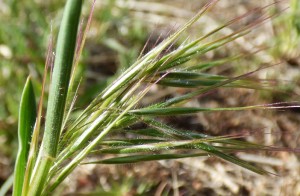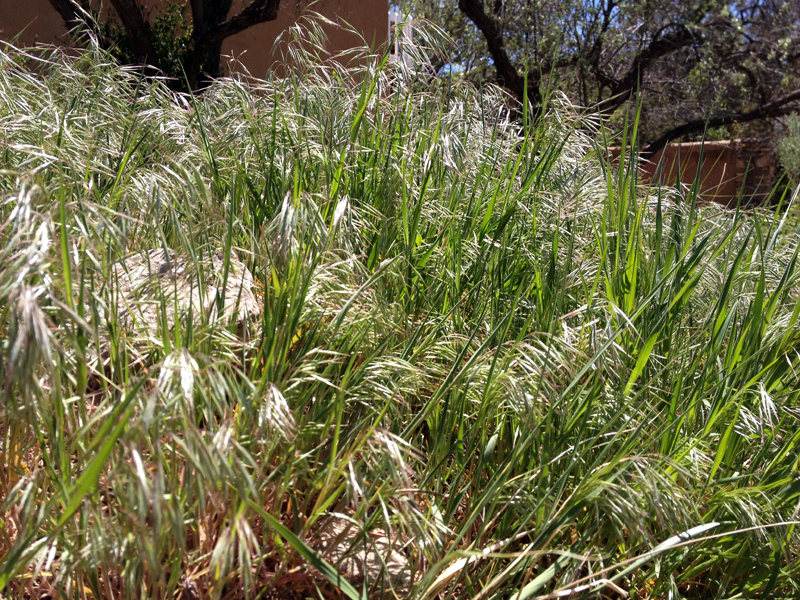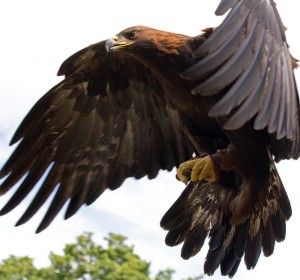It’s cheatgrass time in Santa Fe, and beside every street those foot-tall seas of delicate green seed heads are waving in the May breezes.
Cheatgrass (Bromus tectorum L.) is bad news. Or it is thought to be. Called the “scourge“ of the American West, cheatgrass is deplored by ecologists, botanists, wheat farmers, native plant advocates, and ranchers alike for “infesting” American lands. That’s why a year ago, before reseeding our yard with native grasses and wildflowers, I spent a lot of time pulling it. Getting rid of cheatgrass is the first step in any successful restoration with native plants.
Given that each stem can produce up to 1000 seeds, and given the sheer mass of it—filling a 90-gallon trash bin twice—I figure I removed some 20 million seeds from this yard.
It worked. This year, cheatgrass is down by more than half. A few more years of careful weeding, and cheatgrass would be gone from this yard, all archived seed in the ground removed.
I love pulling cheatgrass—those tiny roots, slipping so easily from the soil! Those furry lavender stems, so soft! Sometimes I pull it just for fun, because it’s the easiest invasive to pull, and weeding it is quiet and meditative, giving me time to listen to rustle and twitter of birds in the yard.
And yet.
Every time I bend to the ground hunting cheatgrass, there’s a little nagging voice in my mind. It sounds something like this:
Do you really know cheatgrass?
Of course I do! I argue back with all the conventional wisdom I know:
Cheatgrass starves out native plants. It germinates in the fall (not the spring), and overwinters in the form of tiny dormant but green shoots, continuing to grow its root system all winter long. So when spring does come it has a head start on everyone else. It springs into action first, “cheating” other grasses and plants of their moisture and their nitrogen. It spreads so early and so fast that others can’t get a foothold.
When cheatgrass moves in, native animals move out. This story reports on a decline in golden eagles in Utah’s western desert because cheatgrass crowded out the sagebrush. Without sagebrush, jackrabbits had no place to hide. Without rabbits in the area, eagles had no reason to visit or nest there.
Cheatgrass lengthens wildfire season. Cheatgrass sprouts early and matures early, so by June it is already dry and brown. It is flammable 1–2 months before other plants and stays flammable 1–2 months after, according to this widely quoted BLM research paper by Mike Pellant.
Cheatgrass increases wildfires and vice versa. Cheatgrass has a special relationship with fire. It moves into burned zones more quickly than most plants, transforming each new region into a cheatgrass monoculture, which in turn is more likely to burn. Some ecologists say that the fire cycle in sagebrush lands has shortened from a 40- to 100-year cycle before cheatgrass to a 5-year cycle since it arrived. And with each fire, cheatgrass grows stronger. Pellant reports that after a wildfire cheatgrass changes its pollinating strategy. Under normal conditions it is a self-pollinator, but after a fire cheatgrass cross-pollinates, becoming even more vigorous and adaptable.
Cheatgrass warms the soil. According to Pellant, the soil in grasslands is about 18 degrees F warmer than in sagebrush lands. So when cheatgrass turns a region into grasslands, the area warms, favoring the cheatgrass even more. Bad news for a changing climate as well.
 Grazing animals don’t eat it. Cheatgrass seeds have long awns, the needle-sharp bristles at the ends of every seed casing. The conventional wisdom says that animals may browse on the plant when it is green, but they avoid it as soon as it puts out seed because the sharp awns hurt their mouths. So the vast rangelands of the American West are being blanketed by a crop that, it is thought, feeds no one or, at best, is undependable. Moreover, cheatgrass shortens the grazing season because once it takes over, there are no more late-season plants to eat.
Grazing animals don’t eat it. Cheatgrass seeds have long awns, the needle-sharp bristles at the ends of every seed casing. The conventional wisdom says that animals may browse on the plant when it is green, but they avoid it as soon as it puts out seed because the sharp awns hurt their mouths. So the vast rangelands of the American West are being blanketed by a crop that, it is thought, feeds no one or, at best, is undependable. Moreover, cheatgrass shortens the grazing season because once it takes over, there are no more late-season plants to eat.
I knew cheatgrass was bad news. I had fun getting it out of my yard.
And yet . . .
. . . there was that pesky little voice inside asking its bothersome questions:
What is the big picture here? What about a hundred years down the road?
Which led to the peskiest question of all:
Does cheatgrass perhaps know something you don’t?
When I hear contrarian questions like this, I try to pay attention. Especially because I am on the spiritual path of listening to Nature-Source, I try to listen for subtler voices. Even when they challenge all the conventional wisdom. Even when I don’t want to hear them, which is way more often than I care to admit.
I’m all too aware that what looks like disaster from a current human perspective can point to a deeper, longer-range wisdom about living sustainably and joyfully on Earth. Like the bark beetle “catastrophe.” From another perspective—say, that of the forest, the same forest that looks to human eyes like it’s being decimated—a bark beetle epidemic might just be the very thing that saves the forest.
So for a year I’ve been living with these nagging questions about cheatgrass. They have sent me searching for a deeper story. I’ve been digging in scientific literature, interviewing USDA researchers, and hunting down whatever I can find about the history of cheatgrass.
The most surprising thing I’ve learned is how little attention is being paid to cheatgrass itself. Almost no one writes about one very basic, scientific question: What ecological niche does cheatgrass fill? What services does provide to its surroundings? Or, to ask it in terms of relationships: How does cheatgrass fit into the larger give-and-take of its eco-community? The voices arrayed against cheatgrass and the urge to eliminate it are so overwhelming that almost nothing can be found about, say, what cheatgrass might know that we don’t.
My research is continuing. I will report on it soon. (And if you know something about the ecological niche question, please share it with us in the comments.)
In keeping with my spiritual path of listening to Nature-Source, I’m going to consult with cheatgrass itself. Or at least try opening my mind enough to make it possible. I have to say, this one is stretching me. The conventional wisdom is so strong, and I’m such a native plant enthusiast, that it’s taking me some time to seriously open to learning from cheatgrass.
But now that my mind is opening, there is the other half of the relationship to consider: After those 20 million seeds, why would cheatgrass want to talk to me?
Stay tuned for the rest of this story.
Update: Six months after this post, the New York Times published “Researcher Finds Way to Fight Cheatgrass, a Western Scourge,” by Christopher Solomon.


Lovely article! I would like to be updated on this topic as soon as possible. I know that Mother Earth sends our plants/seeds where she feels it is most needed.
Usually to build the soil, feed the pollinators and/or clean up toxins from the earth.
Thank you again…
Sandy
Hi, Sandy, thanks for dropping by! Yes, I’m curious about how we might work WITH cheatgrass instead of spending so many efforts working against it.